MAO ZEDONG
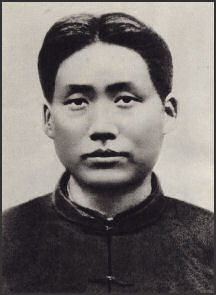
Mao in Wuhan in 1927 Mao Zedong (1893-1976) was one of the major figures of the 20th century. "If power is measured by impact on people's lives," Emily MacFarquhar wrote in U.S. News and World Report, "Mao Zedong was the most powerful man in history. The wars and revolution and political campaigns he led left no one untouched in a country of hundreds of millions. His quixotic crusades may have killed more people than the mass exterminations of Hitler and Stalin combined. In his lifetime, he was worshiped as a god and his books sold better than the Bible. After his death, he was demystified and dethroned. Today, he is the object of a pop culture cult."
Mao's biography, "Mao: the Unknown Story", by Jung Chang and John Halliday begins in a similar vein: “Mao...who for decades held absolute power over the lives of one quarter of the world’s population, was responsible for well over 70 million deaths in peacetime, more than any other 20th century leader.” Henry Kissinger wrote that a "recent biography" of Mao (presumably "Mao: The Unknown Story") was interesting but "one-sided."
On the positive side, Mao was a brilliant political tactician, a clever, charismatic and persuasive leader, a survivor who time and again outmaneuvered his rivals, and a prolific writer who described himself as an “indefatigable teacher.” He showed his toughness and patience during the Long March and again in his resistance against the Japanese. On the negative side he was obsessed with power and eliminating his enemies and many of his ideas such as the Great Leap Forward were half baked.
Websites: Communist Party History Wikipedia article Wikipedia ; Illustrated History of Communist Party china.org.cn ; Books and Posters Landsberger Communist China Posters ; People’s Republic of China: Wikipedia article Wikipedia ; China Essay Series mtholyoke.edu ; Everyday Life in Maoist China.org everydaylifeinmaoistchina.org; The Long March: Wikipedia article Wikipedia ; Paul Noll site paulnoll.com ; Chinese Government Account of Events chinadaily.com; Long March Remembered china.org.cn ; Long March map china.org.cn Mao Zedong Wikipedia article Wikipedia ; Mao Internet Library marx2mao.com ; Paul Noll Mao site paulnoll.com/China/Mao ; Mao Quotations art-bin.com; Marxist.org marxists.org ; New York Times topics.nytimes.com; Early 20th Century China : John Fairbank Memorial Chinese History Virtual Library cnd.org/fairbank offers links to sites related to modern Chinese history (Qing, Republic, PRC) and has good pictures; Sun Yat-sen Wikipedia article Wikipedia ; May 4th Movement Wikipedia article Wikipedia ; Chiang Kai-shek Wikipedia article Wikipedia

Mao in 1910 from his book of Quotations
RECOMMENDED BOOKS:
“From Friend to Comrade: The Founding of the Chinese Communist Party, 1920-1927"
by Hans J. van de Ven Amazon.com;
“The Birth of a Republic” by Hanchao Lu Amazon.com; “Republican China: Nationalism, War, and the Rise of Communism 1911-1949" by Franz Schurmann and Orville Schell Amazon.com;
“The Chinese Enlightenment: Intellectuals and the Legacy of the May Fourth Movement of 1919" by Vera Schwarcz Amazon.com;
"The Generalissimo: Chiang Kai-Shek and the Struggle for Modern China" by Jay Taylor Amazon.com;
“The Unfinished Revolution: Sun Yat-Sen and the Struggle for Modern China”
by Tjio Kayloe Amazon.com;
The Cambridge History of China, Vol. 12: Republican China, 1912-1949, Part 1 by John K. Fairbank Amazon.com;
The Cambridge History of China, Vol. 13: Republican China 1912-1949, Part 2
by John K. Fairbank and Albert Feuerwerker Amazon.com;
"Mao; the Untold Story" by Jung Chang and Jon Halliday (Knopf. 2005) Amazon.com;
"Mao's New World: Political Culture in the Early People's Republic" by Chang-tai Hung (Cornell University Press, 2011) Amazon.com;
“Mao Zedong: The Complete Works Volume 1" (Before 1934) Amazon.com;
“Penguin History of Modern China: 1850-2009” by Jonathan Fenby Amazon.com;; "China: A New History" by John K. Fairbank Amazon.com
RELATED ARTICLES IN THIS WEBSITE: REPUBLICAN CHINA, MAO AND THE EARLY COMMUNIST PERIOD factsanddetails.com; JAPAN IN CHINA: WAR AND OCCUPATION BEFORE AND DURING WORLD WAR II factsanddetails.com; EARLY COMMUNISTS IN CHINA factsanddetails.com; EARLY CHINESE COMMUNIST IDEOLOGUES AND THEIR IDEAS AND GOALS factsanddetails.com; MAO ZEDONG’S EARLY IDEAS ABOUT MAOISM AND REVOLUTION factsanddetails.com; MAO ZEDONG AND GUERILLA TACTICS factsanddetails.com; LONG MARCH: HARDSHIPS, YENAN, MYTH AND REALITY factsanddetails.com; EDGAR SNOW'S ACCOUNT OF "THE LONG MARCH" factsanddetails.com; COMMUNISTS TAKE OVER CHINA factsanddetails.com; FAMOUS ESSAYS BY MAO ZEDONG AND OTHER CHINESE COMMUNISTS AS THEY TAKE POWER factsanddetails.com; EARLY COMMUNIST CHINA UNDER MAO factsanddetails.com; MAO'S PERSONALITY CULT, LEADERSHIP AND MAOIST PROPAGANDA factsanddetails.com MAO'S PRIVATE LIFE AND SEXUAL ACTIVITY factsanddetails.com; JIANG QING, LIN BIAO, ZHOU ENLAI factsanddetails.com; CHINA, THE KOREAN WAR, POWS, SPIES AND THE C.I.A. factsanddetails.com; CHINESE TAKEOVER OF TIBET IN THE 1950s factsanddetails.com; COMMUNES, LAND REFORM AND COLLECTIVISM IN CHINA factsanddetails.com; DAILY LIFE IN MAOIST CHINA factsanddetails.com; BAREFOOT DOCTORS AND HEALTH CARE IN THE MAO ERA factsanddetails.com; KARL MARX: HIS LIFE, IDEAS, BOOKS, HEGEL AND MARXISM factsanddetails.com; SOCIALISM, COMMUNISM, CAPITALISM, LENINISM AND MAOISM factsanddetails.com
Mao's Early Life
Mao Zedong was the eldest son in a prosperous peasant family. He was born in December, 1893 on a canopy bed in his family’s tidy, 13-room farm house, set in a beautiful location outside Shaoshan, Hunan Province in central China. During the Cultural Revolution, the Red Guard chanted "The sun rises in Shaoshan" and some Chinese changed their name to Shaoshan in Mao's honor. In the 1960s, three million people a year visited Mao's house, with as many as 120,000 showing up on a single day. Some treated it as a of pilgrimage site, trekking their on foot from some far off place. Today only a handful of people visit Mao's house each day and the train to Shaoshan is often half empty.
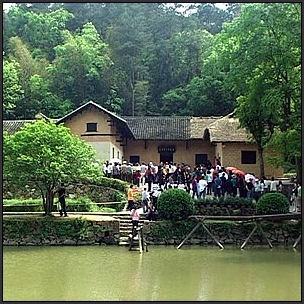
Mao's family houseMao was the oldest surviving child in his family. He had two younger brothers. Mao was large for his age. He liked to eat fermented tofu and compose poetry, According to one story he read history books while he swam in the Xiang River. He reportedly developed his love for swimming in the fish pond in front of his childhood home.
Mao's father was able to afford his school fees. Mao attended primary school in Shaoshan from ages 8 to 13. He was required to help out on the family farm from a young age. Shaoshan was a typical farming village where many people struggled with poverty and hunger. He was trained in Confucian classics and worked as an accountant in his father's business while in school. At age 13 Mao worked full-time for his father, but intellectual curiosity eventually drove him to seek out new teachers in a neighboring town. After Mao left his hometown as a teenager as far as anyone knows only returned twice. [Source: David McNeill, The Independent, August 21, 2008]
At the age of 16, Mao went to Changsa, near Shaoshan, to attend secondary school. Upon completion of his schooling, he went to Beijing (now Beijing) to study at Peking University, and there first became involved in political groups that would evolve in to the Chinese Communist Party. One of Mao's greatest heros when he was young was Qin Shi Huangdi, the first emperor of China. Not yet a radical he wrote that: "I considered the emperor as well as most officials to be honest, good and clever men." As he got older Mao became more radical. His favorite novel reportedly was "The Water Margin", an epic story about a group of insurgents who lived during the Song dynasty.
Mao and His Mother and Father
Mao's father was a "relatively rich peasant" who as a young man had his land taken away and was forced to serve in the army to pay off some large debts. After being released from the army he worked and saved enough money to buy back his land. He became a "rich peasant" by selling surplus rice and buying up rice from poor farmers and selling it a higher price to rice merchants. When Mao was a teenager, his father made a killing by village standards by buying up mortgages from poor peasants and making a profit on the interest the peasants paid him.
Mao was close to his mother. She studied Buddhism and had bound feet. He regarded his father as a disciplinarian whom he once said, "I learned to hate.” According to one fable, Mao was accused of being lazy and fat and slugged by his father in front of guests at a house party. Mao reportedly told his father to go to hell but then allowed him to save face by saying, "Confucius says elders must be kind and affectionate to the young. However I will kowtow on one knee if you promise not beat me."
Mao Works as a Student, Teacher and Librarian in Changsa
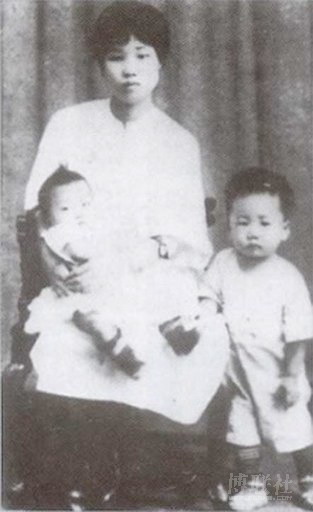
Mao's 1st wife Yao Ka in 1924
When Mao was a young boy a severe famine hit the Hunan province and the Manchu governor was killed in a food riot. Mao wrote he "felt that there with the rebels were ordinary people like my own family and I deeply resented the injustice in the treatment given to them." Around the same time Mao wrote he was impressed by the tactics used by some rebels in the hills around Shaoshan to fight rich landowners and was also taken with a radical school teacher who argued that Buddhist temples should be converted into schools.
After the collapse of the Qing dynasty in 1911, Mao joined the Chinese army but quit six months later. Between 1913 and 1918, Mao attended the Hunan No. 1 Teacher's Training School in Changsa and returned there in 1920 to work for a year as a teacher. In Changsa, Mao was exposed to the revolutionary ideas preached by Sun Yat-sen, heard about the Canton and Wuhan uprisings and read about socialism in Russia in the newspapers. Mao started a night school for farmers in 1917. Describing his early years in Changsa, Mao wrote, "At this time my mind was a curious mixture of ideas of liberalism, democratic reformism and utopia socialism...and I was definitely antimilitarist and anti-imperialist." In the 1920s Mao founded the Cultural Book Society and its affiliated bookstore. With the aim of reforming academic studies and introducing new Chinese and foreign publications. Mao never mastered China’s dominant language Mandarin but he was respected for his calligraphy
Reporting from Changsha, Didi Kirsten Tatlow wrote in the New York Times: “As a young man, Mao attended schools in Changsha, including a teacher-training college that charged no tuition and offered cheap board and lodging, he told Edgar Snow, as the American journalist recounted in “Red Star Over China.” “During this period my political ideas began to take shape,” Mao told Snow. “Here also I acquired my first experiences in social action.” He read Adam Smith and German philosophers in Changsha’s public library, which opened in 1905 under the influence of Western missionaries. [Source: Didi Kirsten Tatlow, New York Times, May 7, 2017]
“Mao organized student and worker strikes in Changsha, helping shape a peasant movement of the kind that would later take all of China. Hunan is known for its reverence for scholarship. “Reflecting both those soldierly and scholarly values, Mao went on vigorous treks through the Hunan countryside. He believed that the Chinese must become stronger if they were to throw out the imperialists and missionaries. “Changsha was a hub of Christianity. The Yale Foreign Missionary Society, later the Yale-China Association, was founded here in 1901, a connection that endures. New Haven, home to Yale, is developing a sister city relationship with Changsha.
Mao Becomes a Communist
In Changsa, Mao became editor of a radical student newspaper called the Xiang River Review. In 1920 he began organizing workers and calling himself a Marxist. He recruited new members for the Communist Party with an ad in the local Changsa newspaper "inviting young men interested in patriotic work to make contact with me." This is how Mao met Liu Shaoqi, later an important general in the Long March and a president of China, and Xiao Chen, a founding member of the Communist Party.
In 1918 Mao worked as an assistant to the chief librarian of the University of Beijing, where he first began to study Marxism seriously and where he met with many of the founders of the Communist Party. When Mao returned to Changsa, he wrote, "I became more and more convinced that only mass political power, secured through mass action, could guarantee the realization of dynamic reforms."

Chen Duxin and the Department of Philosophy graduates, 1918
“The National University of Beijing became the first centre of where the May 4th Movement evolved into the early communist movement. Wolfram Eberhard wrote in “A History of China”: and Chen Duxiu (Ch'en Tu-hsiu), then dean of the College of Letters, from 1920 on became one of its leaders. The Director of the University Library, Li Dazhao (Li Ta-chao), turned towards communism. With him we find one of his employees in the Library, Mao Zedong. In fact, the nucleus of the Communist Party, which was officially created as late as 1921, was a student organization including some professors in Beijing.” Mao later gave up his studies in Beijing and had returned to his home in Hunan, where, he organized his countrymen, the farmers of Hunan.
It is said that at the verge of the northern expedition of Chiang Kai-shek in 1928, Mao's adherents in Hunan already numbered in the millions; this made the quick and smooth advance of the communist-advised armies of Chiang Kai-shek possible. Mao developed his ideas in written form in 1927; he showed that communism in China could be successful only if it was based upon farmers. Because of this unorthodox attitude, he was for years severely attacked as a deviationist. See Separate Articles MAY 4TH MOVEMENT AND THE POLITICAL IDEAS AND REFORMERS ITS SPAWNED factsanddetails.com EARLY CHINESE COMMUNIST IDEOLOGUES AND THEIR IDEAS AND GOALS factsanddetails.com
In 1921, Mao attended the founding meeting of the Chinese Communist Party in Shanghai. In 1922 he organized the Hunan provincial branch of the Communist Party and set up labor and student unions. His revolutionary activities among peasant angered landlords in Hunan and Mao was forced to flee to Canton, where the Kuomintang and Communists held power as allies. With the 1927 split between the Kuomintang and the Chinese Communist Party (CCP), the CCP began to engage in armed struggle against the Chiang regime. The Red Army was established in 1927, and after a series of uprisings and internal political struggles, the CCP announced the establishment in 1931 of the Chinese Soviet Republic under the chairmanship of Mao in Jiangxi Province in south-central China.
In 2014, the Taiwanese newspaper the China Post reported: “ Mao Zedong was once on the payroll of the Kuomintang, archives from Taiwan's ruling party show. Mao joined the KMT in the 1920s when the Nationalists adopted policy of tolerance by befriending the Soviet Union and the Chinese communists in a bid to unite the war-torn country. The archives show that Mao received a salary of “120 Yuan” from the KMT in 1924. [Source: China Post, July 27, 2014]
Chinese Communists Flee to Jiangxi, Where Mao is Based
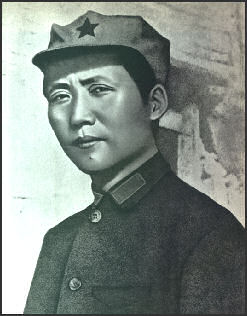 According to Columbia University’s Asia for Educators: The crackdown on the Communist Party in 1927 and the assassination of key members “ drove the main Communist Party leadership underground in Shanghai. It also drove Mao Zedong, a Communist Party member, into the remote rural area of Jiangxi Province, where he and his supporters established a based area and created an army to defend themselves. It was in the context of fighting with the numerically superior and better-equipped Kuomintang forces that Mao developed and applied his theories of guerrilla warfare. Mao and the Communists continued to employ guerrilla warfare in the struggle against the Japanese beginning in 1937.” [Source: Asia for Educators, Columbia University, Primary Sources with DBQs, afe.easia.columbia.edu ]
According to Columbia University’s Asia for Educators: The crackdown on the Communist Party in 1927 and the assassination of key members “ drove the main Communist Party leadership underground in Shanghai. It also drove Mao Zedong, a Communist Party member, into the remote rural area of Jiangxi Province, where he and his supporters established a based area and created an army to defend themselves. It was in the context of fighting with the numerically superior and better-equipped Kuomintang forces that Mao developed and applied his theories of guerrilla warfare. Mao and the Communists continued to employ guerrilla warfare in the struggle against the Japanese beginning in 1937.” [Source: Asia for Educators, Columbia University, Primary Sources with DBQs, afe.easia.columbia.edu ]
Dr. Eno wrote: “In 1927, as a result of Stalin’s loyal guidance, the CCP was all but exterminated by the Nationalists in a surprise coup. Those communist leaders who were not killed outright had to flee their base territories in China’s cities, where they had been trying to mobilize factory workers. The safe haven where the Chinese communist leaders fled in 1927 was the mountain fastnesses of the province of Jiangxi. One member of the leadership was already based in Jiangxi, having convinced the Party to allow him to go there to test out a new theory about how communism should be adapted to the Chinese case. That leader was Mao Zedong, and the theory he was testing eventually became the most basic distinctive feature of Chinese communism: the theory of the Revolutionary Peasantry.
Mao’s Rise in the Early Years of the Chinese Communist Party
Mao Zedong, who had become a Marxist at the time of the emergence of the May Fourth Movement (he was working as a librarian at Beijing University), had boundless faith in the revolutionary potential of the peasantry. He advocated that revolution in China focus on them rather than on the urban proletariat, as prescribed by orthodox Marxist-Leninist theoreticians. Despite the failure of the Autumn Harvest Uprising of 1927, Mao continued to work among the peasants of Hunan Province. Without waiting for the sanction of the CCP center, then in Shanghai, he began establishing peasant-based soviets (Communist-run local governments) along the border between Hunan and Jiangxi provinces. In collaboration with military commander Zhu De (1886-1976), Mao turned the local peasants into a politicized guerrilla force. By the winter of 1927-28, the combined "peasants' and workers'" army had some 10,000 troops. [Source: The Library of Congress]
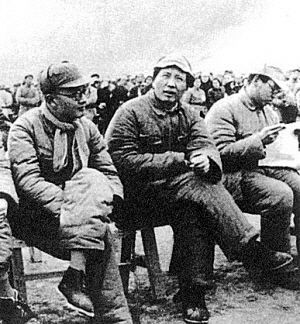
Mao in the 1930s Mao's prestige rose steadily after the failure of the Comintern-directed urban insurrections. In late 1931 he was able to proclaim the establishment of the Chinese Soviet Republic under his chairmanship in Ruijin, Jiangxi Province. The Soviet-oriented CCP Political Bureau came to Ruijin at Mao's invitation with the intent of dismantling his apparatus. But, although he had yet to gain membership in the Political Bureau, Mao dominated the proceedings.
“In the early 1930s, amid continued Political Bureau opposition to his military and agrarian policies and the deadly annihilation campaigns being waged against the Red Army by Chiang Kai-shek's forces, Mao's control of the Chinese Communist movement increased.
Mao Organizes a Communist State and Guerilla Army
In 1927, Mao led a group of Hunan peasants in the mountains of Jiangxi Province, where they created a Soviet-style government and started building a guerilla force. By 1930 the Jiangxi Soviet controlled several million people and the Red Army numbered 200,000. In the meantime the Kuomintang began a campaign to exterminate the Communists.
In the 1930s Mao traveled to villages, where peasants grew rice for wealthy landlords and ate nothing but potatoes themselves, and called on them to take up arms and take the land for themselves.
At that time Mao was described as tall, rangy and good looking. He chain smoked and looked people directly in the eye, exuded coincidence and persuaded peasants with his logic and charisma.
Mao received trunks full of Mexican silver dollars and instructions from Soviet leader Joseph Stalin, without which many historians have argued the Long March would not have been possible. Stalin is said to have played a major role in Mao’s rise. Betrayal and intra party rivalry led to frequent purges. Blunders by Mao led to the unnecessary loss of thousands in hopeless battles.
Mao Takes Over the Communist Party
Against the advise of Mao and his followers, Li Lisan, leader of the Communist Party at that time, committed 180,000 men to a series of great battles in the early 1930s against the Kuomintang, who was being advised by Prussian officers who taught the Kuomintang how to build forts and fortify supply lines to entrap their enemy. The Communists lost the battles and their movement almost collapsed.
Mao took control of the Communist Party after he refused Li's orders to lead a major offensive against Changsa. During the Long March Mao consolidated his hold over the CCP. Shortly after the march began, Mao was elected chairman of the Communist Party at a politburo conference in Kweichow in 1935. With Mao at the helm, the Communists stuck to guerilla warfare and avoided large battles.

Mao and other participants in the 1927 Autumn Harvest riot
Image Sources: Mao's House; BBC; Other images Nolls website http://www.paulnoll.com/China/index.html, Ohio State University, Wikimedia Commons,
Text Sources: Asia for Educators, Columbia University afe.easia.columbia.edu; Robert Eno, Indiana University/+/ ; Library of Congress; New York Times; Washington Post; Los Angeles Times; China National Tourist Office (CNTO); Xinhua; China.org; China Daily; Japan News; Times of London; National Geographic; The New Yorker; Time; Newsweek; Reuters; Associated Press; Lonely Planet Guides; Compton’s Encyclopedia; Smithsonian magazine; The Guardian; Yomiuri Shimbun; AFP; Wikipedia; BBC. Many sources are cited at the end of the facts for which they are used.
Last updated August 2021
